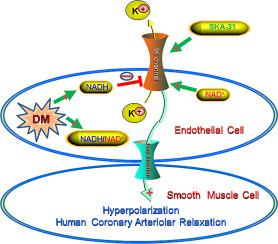International Journal of Cardiology ( IF 3.2 ) Pub Date : 2020-03-12 , DOI: 10.1016/j.ijcard.2020.03.028 Yuhong Liu 1 , Anatoli Y Kabakov 2 , An Xie 3 , Guangbin Shi 1 , Arun K Singh 1 , Neel R Sodha 1 , Afshin Ehsan 1 , Anny Usheva 1 , Vahid Agbortoko 1 , Gideon Koren 2 , Samuel C Dudley 3 , Frank W Sellke 1 , Jun Feng 1

|
Background
Diabetic (DM) inactivation of small conductance calcium-activated potassium (SK) channels contributes to coronary endothelial dysfunction. However, the mechanisms responsible for this down-regulation of endothelial SK channels are poorly understood. Thus, we hypothesized that the altered metabolic signaling in diabetes regulates endothelial SK channels and human coronary microvascular function.
Methods
Human atrial tissue, coronary arterioles and coronary artery endothelial cells (HCAECs) obtained from DM and non-diabetic (ND) patients (n = 12/group) undergoing cardiac surgery were used to analyze metabolic alterations, endothelial SK channel function, coronary microvascular reactivity and SK gene/protein expression/localization.
Results
The relaxation response of DM coronary arterioles to the selective SK channel activator SKA-31 and calcium ionophore A23187 was significantly decreased compared to that of ND arterioles (p < 0.05). Diabetes increases the level of NADH and the NADH/NAD+ ratio in human myocardium and HCAECs (p < 0.05). Increase in intracellular NADH (100 μM) in the HCAECs caused a significant decrease in endothelial SK channel currents (p < 0.05), whereas, intracellular application of NAD+ (500 μM) increased the endothelial SK channel currents (p < 0.05). Mitochondrial reactive oxygen species (mROS) of HCAECs and NADPH oxidase (NOX) and PKC protein expression in the human myocardium and coronary microvasculature were increased respectively (p < 0.05).
Conclusions
Diabetes is associated with metabolic changes in the human myocardium, coronary microvasculature and HCAECs. Endothelial SK channel function is regulated by the metabolite pyridine nucleotides, NADH and NAD+, suggesting that metabolic regulation of endothelial SK channels may contribute to coronary endothelial dysfunction in the DM patients with diabetes.
中文翻译:

内皮SK通道和人冠状微血管功能的代谢调节。
背景
糖尿病(DM)小电导钙激活钾(SK)通道失活会导致冠状动脉内皮功能障碍。然而,人们对内皮 SK 通道下调的机制知之甚少。因此,我们假设糖尿病中代谢信号的改变可调节内皮 SK 通道和人冠状微血管功能。
方法
使用从接受心脏手术的 DM 和非糖尿病 (ND) 患者(n = 12/组)获得的人心房组织、冠状动脉和冠状动脉内皮细胞 (HCAEC) 来分析代谢改变、内皮 SK 通道功能、冠状动脉微血管反应性和 SK 基因/蛋白质表达/定位。
结果
与 ND 小动脉相比,DM 冠状动脉对选择性 SK 通道激活剂 SKA-31 和钙离子载体 A23187 的舒张反应显着降低 (p < 0.05)。糖尿病会增加人心肌和 HCAEC 中的 NADH 水平以及 NADH/NAD +比率 (p < 0.05)。 HCAEC 中细胞内 NADH (100 μM) 的增加导致内皮 SK 通道电流显着降低 (p < 0.05),而细胞内应用 NAD + (500 μM) 会增加内皮 SK 通道电流 (p < 0.05)。 HCAECs 的线粒体活性氧 (mROS) 以及人心肌和冠状微血管中的 NADPH 氧化酶 (NOX) 和 PKC 蛋白表达分别增加 (p < 0.05)。
结论
糖尿病与人类心肌、冠状动脉微血管和 HCAEC 的代谢变化有关。内皮SK通道功能受代谢物吡啶核苷酸NADH和NAD +的调节,提示内皮SK通道的代谢调节可能导致糖尿病患者冠状动脉内皮功能障碍。










































 京公网安备 11010802027423号
京公网安备 11010802027423号